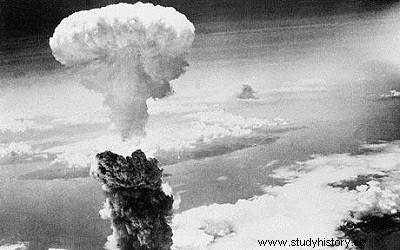
The balance of terror or mutually assured destruction (DMA, or MAD in English) is a doctrine of military strategy of nuclear deterrence.
Developed during the Cold War era, by the Soviet Union (and its Warsaw Pact satellites) on the one hand and the United States (and its NATO allies) on the other. , this doctrine asserts that the large-scale use of nuclear weapons by one of the two belligerents would certainly cause the destruction of both sides. For this purpose, it is necessary for each protagonist to have a stock of weapons of mass destruction sufficient to annihilate the enemy.
This is the extreme form of deterrence, where the benefits of an attack would be invalidated by the losses, since each of the belligerents would be annihilated. This strategy is a form of Nash equilibrium, in which each of the parties can only break the equilibrium by exposing itself to being destroyed.
Doctrine
The doctrine implied by this expression is analyzed as the capacity for each block to annihilate the other by a massive nuclear attack in the event of aggression:the first which tries to destroy the other is in a way guaranteed to be destroyed in turn, completely nullifying the interest of such an attack. The constituted powers represented forces of destruction capable of “blowing up the planet several times”, according to a popular expression very fashionable at the time, in the event of nuclear war. The Americans are therefore abandoning the doctrine of "massive retaliation" for that of a "graduated response".
Development of nuclear weapons
Despite their warhead limitation agreements, the nuclear weapons stockpile of the two superpowers remains very large.
It was by invoking this doctrine that during the Cold War, the two superpowers, the United States and the Soviet Union, developed a stockpile of nuclear weapons enabling them to destroy each other and prevent an adverse first strike. disarm them.
From October 1, 1957, thanks to the launch of the first artificial satellite, Sputnik 1, the Soviets showed the Americans that they were capable of launching intercontinental missiles.
The development of nuclear-powered ballistic missile submarines (SSBNs) has allowed both sides to have a “second strike” capability in the event of a nuclear attack from the other side.
The quantity of armaments accumulated and deployed on both sides led to the attempt of numerous negotiations, before reaching partial disarmament agreements (for example the SALT agreements or negotiations on the limitation of strategic armaments from 1969 ).
